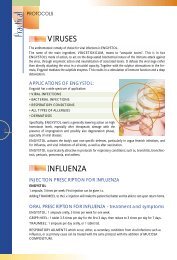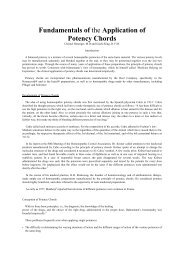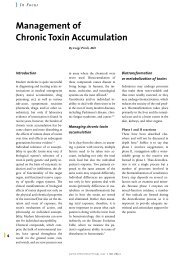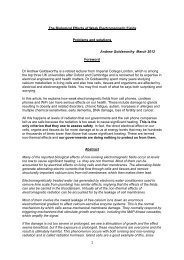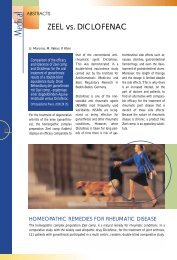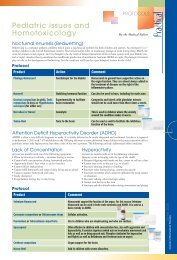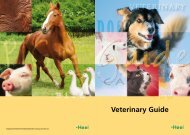Handling The Vaccination Reaction - Bio Pathica Ltd
Handling The Vaccination Reaction - Bio Pathica Ltd
Handling The Vaccination Reaction - Bio Pathica Ltd
Create successful ePaper yourself
Turn your PDF publications into a flip-book with our unique Google optimized e-Paper software.
ColumnVETERINARYBy PJ Broadfoot DVMPuppyatrics - <strong>Handling</strong>the vaccination reaction14Journal of <strong>Bio</strong>medical <strong>The</strong>rapyWinter 2006In recent years, we have been rather interested to realize that the incidence of hypersensitivity reactions has been increasingin the veterinary practice. This is particularly evident in juvenile puppies, as a result of the vaccination procedures. Thoughwe consider immunization to be of importance in these young animals, due to the ongoing presence of devastating viraldiseases such as distemper and parvoviral enteritis, we have continually found ourselves “downsizing” our protocols to a bareminimum, as we have observed an influx of vaccination reactions. Despite reducing the number of “jabs”, and limiting theantigens in the vaccines, we still see reactions.Puppies less than six months old are more susceptible to the common infectious diseases than adults, and therefore are theprimary target population for vaccination. 1 In the US, the incidence of clinical disease from distemper, infections hepatitis,and parvovirus in dogs older than one year of age is virtually zero.High levels of maternal antibodies acquired from ingestion of colostrum protect puppies from disease for the first six toeight weeks of life. Following this, a window of susceptibility to infection is created because maternal antibodies are highenough to interfere with the vaccine-induced response, but not high enough to protect the pup from infection and disease.This is the most common cause of vaccine failure in puppies. <strong>The</strong>refore, immunizations are repeated at timed intervals toensure development of a protective immune response. <strong>The</strong> pediatric series includes the core vaccines for distemper, parvovirus,and infectious canine hepatitis starting with an initial immunization at six to eight weeks of age. This is followedby boosters every three to four weeks until 12-14 weeks old. Certain breeds have a higher frequency of individuals that do notdevelop vaccine-induced antibody titers during the routine pediatric series, including the Rottweiler, Doberman pinscher,Labrador retriever, Alaskan sled dog, Pomeranian, and American Staffordshire terrier. Extended vaccination schedules areoften proposed for these breeds.Vaccines containing killed coronavirus combined with killed leptospirosis bacteria targeted for use in puppies should not beused due to increased frequency of hypersensitivity reactions. Canine leptospirosis is a bacterial infection that causes kidneyand liver failure in dogs of all ages. <strong>The</strong>re are several different serovars, which are antigenically distinct from each other, andstrains are not cross-protective. <strong>The</strong> killed bacteria suspended in adjuvant are responsible for many hypersensitivity reactions,particularly in Dachshunds and other small breeds, and only induce a short-lived immunity of six to eight months. 1Type 1 (immediate) hypersensitivity reactions involve antigen specific IgE or IgG on the surface of a mast cell or basophil,resulting in degranulation and release of vasoactive substances. <strong>The</strong>se can be seen within minutes in most cases or be delayedup to 24 hours post-exposure. Though we generally see fairly local response, they can be quite severe and generalized. Indogs, the primary manifestations are facial pruritis and edema, hives and urticarial lesions. More severe cases can showhypotension, dyspnea, diarrhea and collapse. Cats have more respiratory signs, including dyspnea, shock, salivation, andpulmonary edema. Miniature Dachshunds are over represented in the literature. A more minor reaction, yet one of concernto owners, is a very localized reaction, in the form of a sub-cutaneous mass at the injection site, occasionally painful, whichtends to be transient in nature. We have considered the possibility that this may suggest some increased sensitivity in theaffected patients. <strong>The</strong> granuloma may not appear for several weeks post-vaccination, and it is thought that this is a localreaction to the adjuvants in vaccine.In our practice, we see a disproportionate number of young canines that react, represented by Dachshunds, Pugs, andBoston terriers, with a smattering of other breeds. Interestingly, we also see a fair number of these breeds presented foratopic issues as well. <strong>Vaccination</strong> has been found to exacerbate the immune response of dogs with preexisting inhalantallergies. Vaccine antigens may potentially exceed the immunologic tolerance threshold of some animals with atopy. <strong>The</strong>more antigens administered in a vaccine, the greater the chance of inducing hypersensitivity. Often it is difficult to linkthis kind of tissue damage to vaccination, but this may be due to the fact that damage tends to be caused by the accumulationof many antigens from many vaccines over years of a dog’s life, rather than from any one given vaccine. We mostassuredly see a distinct worsening of allergies within 2-4 weeks post-vaccination in sensitized dogs.In light of this, we have developed some therapeutic regimens for vaccination reactions in those puppies that return to us,within an hour or so post-vaccination bearing a vague resemblance to a platypus. In addition to the facial edema, they maymanifest wheals and urticaria, and varying degrees of pruritis. Because this syndrome is reminiscent of bee sting hypersensitivity,we treat symptomatically for it, with a combination of Apis-Homaccord and Lymphomyosot. In many cases, wegive the remedies combined, and administer half the dose in an intravenous injection, for rapid response. <strong>The</strong> remaininghalf, which contains a small amount of blood from the injection IV, is succussed and given sub-cutaneously. <strong>The</strong> dose variesdepending on the size of the patient. Animals under 10 pounds receive 1/4 of a vial, 10-30 pounds get 1/2 a vial, andlarger breeds get a full vial.We have occasionally seen quite dramatic response to this therapy, often within an hour, and there is certainly an arrest ofswelling shortly after treatment. We then send home a mixed Homotoxicology “cocktail” of Apis-Homaccord andLymphomyosot drops, and advise the owners to give 0.25-0.5 ml per dose as needed until the swelling subsides.
VETERINARYColumnJuvenile GermanShepherd withfacial edema,1 hour post-exposureto vaccination.Juvenile GermanShepherd with facialedema, 24 hoursafter therapy.15Incidentally, this particular mixture “lives” in my kitchen, and my children have learned to run for this remedy if stungby bees or wasps, and they have had the occasion to test out its efficacy over the years. I use it topically, for wheals andpruritis brought on by skin irritants, and can personally attest to its ability to arrest the annoying itching welts that cropup randomly. <strong>The</strong> same remedy works well on dogs for similar contact irritations. It has also made the trip to Nicaraguawith a missionary group, where it proved to be a useful remedy when one of the workers awoke with severe facial swelling,presumably due to an insect bite. A few doses of the Apis-Homaccord and Lymphomyosot (10-15 drops every 15 minutes),and she was markedly improved and able to participate in the remainder of the day’s work.Also to be considered is the excellent effect of Engystol, due to the combination effect of Vincetoxicum officinale (asclepias)and sulfur. Engystol has had good effects on various skin diseases such as neurodermitis, urticaria, eczema, furunculosis, aswell as on diseases of the respiratory organs, especially asthma, cardiac and circulatory diseases, and therefore should beconsidered in feline vaccine reactions, as there is a strong respiratory component to their manifestations of hypersensitivity.Enygstol is dosed at 1/2cc in acute feline asthma cases. We frequently will give part of this intravenously. <strong>The</strong> remedy issuccussed in the syringe, and then the remainder is given as a subcutaneous injection, in the manner of an auto-sanguistherapy. Acute cases, such as the “lumpy puppies” generally respond quite dramatically, and seldom require ongoingtherapy, while the atopic, pruritic skin patients may need long-term support. Long-term support of atopic cases is asubject which merits an entire article, and may be covered at a time in the future.REFERENCE:1. Greene CE, Schultz RD, Ford RB. Canine <strong>Vaccination</strong>. In: North American Veterinary Clinics 2001. Ford RB, ed. 31(3): 473-492.Winter 2006Journal of <strong>Bio</strong>medical <strong>The</strong>rapy



